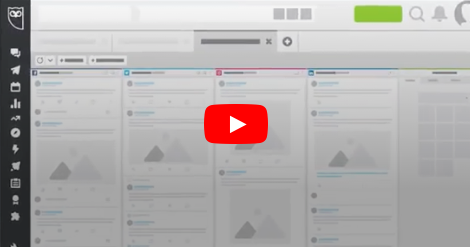Social Media Marketing Strategy
Eight easy steps to develop your social media presence

Contents
Step 1: Set social media marketing goals that align to business objectives
Step 2: Learn everything you can about your audience
Step 3: Research the competition
Step 4: Conduct a social media audit
Step 5: Set up accounts and improve existing profiles
Step 6: Find inspiration
Step 7: Create a social media content calendar
Step 8: Test, evaluate, and adjust your strategy
Step 1: Set social media marketing goals that align to business objectives
The more specific your strategy is, the more effective the execution will be. Set SMART goals and track the right metrics to set yourself up for success.
Set SMART goals
The first step to creating a social media marketing strategy is to establish your objectives and goals. Without goals, you have no way to measure your success or your social media return on investment (ROI).Each of your goals should be:
Specific
Measurable
Attainable
Relevant
Time-bound
An example of a SMART goal for your business might be “Grow our Instagram audience by 50 new followers per week.”With SMART goals, you’ll make sure your goals actually lead to real business results, rather than just lofty ideals.
Track meaningful metrics
While vanity metrics like retweets and likes can be fun to share and easy to track, it’s hard to prove their real value for your business. Instead, focus on targets such as leads generated, web referrals, and conversion rate.You may want to track different goals for different channels, or even different uses of each channel. For example, you can use paid campaigns to increase brand awareness, but measure acquisition and engagement for organic social posts.Make sure to align your social media goals with your overall marketing strategy. This will make it easier for you to show the value of your work and get executive buy-in and investment.Start developing your social media marketing plan by writing down at least three social media goals.

Step 2: Learn everything you can about your audience
if you’re not engaged in social media listening, you’re creating your business strategy with blinders on—and you’re missing out on mountains of actionable insights from real people who are actively talking about you or your industry online.
Here’s how to start listening and building your understanding of your audience and their needs.
Create audience personas
Knowing who your audience is and what they want to see on social is key to creating content that they will like, comment on, and share. This knowledge also critical for planning how to develop your social media fans into customers for your business.
Try creating audience personas. For example, a retail brand might create different personas based on demographics, buying motivations, common buying objections, and the emotional needs of each type of customer.
Personas sharpen your marketing tactics. Luxury buyers, for example, might not respond to Facebook ads with sales. But they might respond to Facebook ads with exclusive in-store events to be the first to see a new line of clothing. With personas, you’ll have the customer insights you need to create campaigns that speak to the real desires and motivations of your buyers.
Gather real-world data
Don’t make assumptions. Social media analytics can also provide a ton of valuable information about who your followers are, where they live, which languages they speak, and how they interact with your brand on social. These insights allow you to refine your strategy and better target your social ads.
Jugnoo, an Uber-like service for auto-rickshaws in India, used Facebook Analytics to learn that 90 percent of their users who referred other customers were between 18 and 34 years old, and that 65 percent of that group was using Android. They used this information to target their ads, resulting in a 40 percent lower cost per referral.

Step 3: Research the competition
Odds are, your competitors are already using social media—and that means you can learn from what they’re already doing.
Conduct a competitive analysis
A competitive analysis allows you to understand who the competition is and what they’re doing well (and not so well). You’ll get a good sense of what’s expected in your industry, which will help you set some social media targets of your own.This analysis will also help you spot opportunities. For example, maybe one of your competitors dominates on Facebook, but has put little effort into Twitter or Instagram. You might want to focus on the networks where your audience is underserved, rather than trying to win fans away from a dominant player.
Engage in social listening
Social listening is another way to keep track of the competition.As you track your competitors’ accounts and relevant industry keywords, you may notice strategic shifts in the way competitors use their social accounts. Or you might spot a specific post or campaign that really hits the mark—or one that bombs.Keep an eye on this information and use to it evaluate your own goals and plans.
Step 4: Conduct a social media audit
Conducting a social media audit helps you assess how well your current social media use works for you.
Evaluate your current efforts
If you’re already using social media tools, you need to take a step back and look at what you’ve already accomplished. Ask yourself the following questions:
What’s working?
What’s not working?
Who’s connecting with you on social?
Which social media sites does your target market use?
How does your social media presence compare to that of your competitors?
Once you gather all this information in one place, you’ll have a good starting point for planning how to improve your results.
Your audit should give you a clear picture of what purpose each of your social accounts serves. If the purpose of an account isn’t clear, think about whether it’s worth keeping. It may be a valuable account that just needs a strategic redirection, or it may be an outdated account that’s no longer worth your while.
To help you decide, ask yourself the following questions:
Is my audience here?
If so, how are they using this platform?
Can I use this account to help achieve meaningful business goals?
Asking these tough questions now will help keep your social media strategy on track as you grow your social presence.
Look for impostor accounts
During your audit process, you may discover fraudulent accounts using your business name or the names of your products—that is, accounts that you and your business don’t own.
These imposter accounts can be harmful to your brand (never mind capturing followers that should be yours), so be sure to report them. You may want to get your social accounts verified to ensure your fans and followers know they are dealing with the real you.

Step 5: Set up accounts and improve existing profiles
Decide which networks you’ll focus on, and then set up and optimize your accounts.
Determine which networks to use (and how to use them)
As you decide which social channels to use, you’ll also need to define your strategy for each network. For example, you might decide to use Twitter for customer service, Facebook for customer acquisition, and Instagram for engaging existing customers.
It’s a good exercise to create mission statements for each network. These one-sentence declarations will help you focus on a very specific goal for each account on each social network.
For example, you could decide that:
Facebook is best for acquiring new customers via paid advertising.
Instagram is where you build brand affinity with existing customers.
Twitter is where you engage press and industry influencers.
LinkedIn is where you engage existing employees and attract new talent.
YouTube is where you support existing customers with education and video help content.
Snapchat is where you distribute content with the goal of building brand awareness with younger consumers.
If you can’t create a solid mission statement for a particular social network, you may want to reconsider whether that network is worth it.
Set up (and optimize) your accounts
Once you’ve decided which networks to focus on, it’s time to create your profiles—or improve existing profiles so they align with your strategic plan.
In general, make sure you fill out all profile fields, use keywords people will use to search for your business, and use images that are correctly sized for each network.

We’ve also got step-by-step guides for each network to walk you through the process:
Create a Facebook business page
Create an Instagram business account
Create a Twitter business account
Create a Snapchat account
Create a LinkedIn Company Page
Create a Pinterest business account
Create a YouTube channel
Create a WeChat business account
Don’t let this list overwhelm you. Remember, it’s better to use fewer channels well than to stretch yourself thin trying to maintain a presence on every social network.
Finally, here’s a quick reference guide for image sizes for every network.
Step 6: Find inspiration
While it’s important that your brand be distinctive and unique, you can still draw inspiration from other businesses that are great on social.
Social network success stories
All of the social networks feature success stories that highlight how brands are using their tools effectively. You can usually find these on the business section of the social network’s website. (For example, take a look at the Facebook business success stories.) These case studies offer valuable insights you can apply to your own goals for each social network.
Award-winning accounts and campaigns
For examples of brands that are at the top of their social media game, check out the winners of The Facebook Awards or The Shorty Awards.
Step 7: Create a social media content calendar
Sharing great content is essential, of course, but it’s equally important to have a plan in place for when you’ll share content to get the maximum impact.
Your social media content calendar also needs to account for the time you’ll spend interacting with your audience (although you need to allow for some spontaneous engagement as well).
Create a posting schedule
Your social media content calendar lists the dates and times at which you will publish types of content on each channel. It’s the perfect place to plan all of your social media activities—from images and link sharing to blog posts and videos.
Your calendar ensures your posts are spaced out appropriately and published at the optimal times. It should include both your day-to-day posts and your content for social media campaigns.
Plot your content mix
Make sure your calendar reflects the mission statement you’ve assigned to each social profile, so that everything you post is working to support your business goals. For example, you might decide that:
50 percent of content will drive traffic back to your blog
25 percent of content will be curated from other sources
20 percent of content will support enterprise goals (selling, lead generation, and so on)
5 percent of content will be about your employees and company culture
Placing these different post types in your content calendar will help ensure you maintain the ratio you’ve planned. If you’re starting from scratch and you’re simply not sure what types of content to post, try the 80-20 rule:
80 percent of your posts should inform, educate, or entertain your audience
20 percent can directly promote your brand
You could also try the social media rule of thirds:
One-third of your social content promotes your business, converts readers, and generates profit
One-third of your social content shares ideas and stories from thought leaders in your industry or like-minded businesses
One-third of your social content involves personal interactions with your audience
Once you have your calendar set, use scheduling tools or bulk scheduling to prepare your posting in advance rather than updating constantly throughout the day. This allows you to focus on crafting the language and format of your posts, rather than writing them on the fly whenever you have time.
Step 8: Test, evaluate, and adjust your strategy
Your social media strategy is a hugely important document for your business, and you can’t assume you’ll get it exactly right on the first try.
As you start to implement your plan and track your results, you may find that some strategies don’t work as well as you’d anticipated, while others are working even better than expected.
Track your data
In addition to using the analytics tools available within each social network, use UTM parameters to track visitors as they move through your website, so you can see exactly which social posts drive the most traffic to your website.
Re-evaluate, test, and do it all again
When data starts coming in, use it to reevaluate your strategy regularly. You can also use this information to test different posts, campaigns, and strategies against one another. Constant testing allows you to understand what works and what doesn’t, so you can refine your strategy in real time.
Surveys can also be a great way to find out how well your strategy is working. Ask your social media followers, email list, and website visitors whether you’re meeting their needs and expectations on social media. You can even ask them what they’d like to see more of—and then make sure to deliver on what they tell you.
Things change fast on social media. New networks emerge, while others go through significant demographic shifts. Your business will go through periods of change as well. All this means that your social media strategy should be a living document that you look at regularly and adjust as needed. Refer to it often to keep you on track, but don’t be afraid to make changes so that it better reflects new goals, tools, or plans.
When you update your social strategy, make sure to let everyone on your social team know, so they can all work together to help your business make the most of your social media accounts.
Bonus: Download our social media strategy template
Does this all feel a little overwhelming? The truth is that building your social media strategy is a substantial job. It should be, since it’s such an important document for your business. But it doesn’t have to be complicated.
We’ve created a template to guide you through the whole process of creating your social media marketing plan. Visit our blog to download it (plus six other social media templates that can save you hours of work).
Take the next leap in your social media career
Hootsuite Academy
Earn industry-recognized social media certifications that will make you stand out from the crowd.
Begin with our free comprehensive training on social marketing. All of our courses are delivered online and taught by expert industry practitioners. Take the free course here.
Build a professional workflow with Hootsuite
From scheduling Instagram posts to advanced ROI measurement, Hootsuite’s flexible platform helps you execute every aspect of your social media strategy. We’re the world’s most widely used platform for managing social media.
Get started with the plan that fits your needs here.
Did you find this guide helpful?
Tell us whether we should praise our writers or shout at them. Either way, we appreciate your honest feedback. Take our 4-minute survey here.




